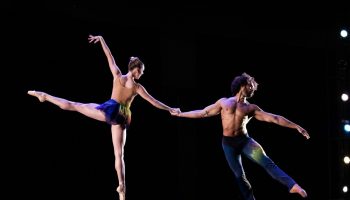Throughout his entire career with Charlotte Ballet (formerly North Carolina Dance Theatre), first as a principal dancer for eight years beginning in 2003, then as company rehearsal director and ballet master, and more recently as associate artistic director and resident choreographer for the company, Sasha Janes has always taken a thoughtful approach to everything he does. It’s a trait that has served the Perth, Australia, native well over the years, especially when it comes to his choreography. From his first piece in 2006, the breathtaking “Lascia la Spina, Cogli la Rosa,” Janes showed a remarkable maturity as a choreographer that usually requires many years to cultivate.
On Thursday night in the Amphitheater, Janes’ choreographic talents were on full display as the annual Chautauqua Dance Salon program featured a full evening of his work performed by dancers from the Charlotte Ballet, along with top student dancers from the Chautauqua School of Dance.
Janes is nicknamed the “King of the Pas de Deux,” so it was apropos that the Salon evening began with one of Janes’ most cleverly constructed and captivating pas de deux, pulled from his ballet “Sketches from Grace.” Set to music by singer-songwriter Jeff Buckley, the pas de deux, titled “You and I,” was danced with feeling by Charlotte Ballet’s Elizabeth Truell and Drew Grant. It began with Grant walking out of darkness through a large doorway at the back of the stage with Truell draped around his shoulders like a scarf. When he finally set her down, she rattled off a succession of quick turns before being once again lifted by Grant to flip over and around his body.
A simmering tension between the two dancers grew apparent, and Buckley’s music fed into that tension. Truell’s facial expressions and dancing were keenly intense, as if the couple was embroiled in a conflict of sorts. Wonderfully danced, this snapshot of a point in these two characters’ lives ended as it began, with Grant walking offstage back into the darkness with Truell passively draped over his shoulders.
Of the mostly reprised ballets from past Chautauqua seasons on the program, “Last Lost Love,” which came next, is Janes at his creative best. The ballet for five dancers performed to music by Ólafur Arnalds, while danced in an abstract, contemporary dance movement style, contained strong emotional narratives which each of the dancers brought to their performances.
The piece opened with Sarah Hayes Harkins darting out onstage in silence and moving through a solo that appeared to slowly pull her back the way she came and eventually into the arms of dancer James Kopecky, who had followed her. The pair moved through partnered choreography that at one point landed both of them on their backs, Kopecky lying on the stage floor holding up the outstretched Harkins with his arms and legs as they both bicycle pedaled their feet together in midair.
An energetic solo by Raven Barkley, who could be seen deliberately pigeon-toed at times, followed. The work then transitioned into another striking pas de deux performed with grace and power by Chelsea Dumas and Josh Hall. In it, Hall lifted Dumas into various positions, including one in which she looked like a diver in pike position frozen in mid-somersault. As with all of Janes’ pas de deux, there is an emotional undercurrent that often tugs at one’s heart and invades one’s soul. Both Hall and Dumas were mesmerizing, Dumas possessing the kind of beauty, facility and talent worthy of cloning.
A Chautauqua audience favorite in recent years, Janes’ “Queen” told of a medieval queen (Dumas) and her champion (Ben Ingel) who no longer wished to enter battle for her. This news did not sit well with the young petulant royal, who then tried to seduce the knight into being her lover to change his mind about fighting again. While the premise of the ballet and its memorable ending showing the queen shooting dead her champion with his own bow carries the day, the busy choreography of the two wrestling each other across the stage is at times clunky and forced.
Originally created for Richmond Ballet in 2013, the last of the program’s three standalone pas de deux came from Janes’ ballet “Dominant Curves.” Set to music by Osso String Quartet and Sufjan Stevens, Harkins was this time paired with a shirtless Hall, and she seductively ran her hand along his chest and six-pack abs. The sensual pas de deux was an athletic and artistic exploration by the dancers of each other’s curves.
The final ballet of the evening was its biggest and one of its best. “Saudade” (Portuguese for “missing” or “longing”), was inspired by the current worldwide refugee crisis. The ballet for six men and 15 women, including nine apprentice and festival dancers from the Chautauqua School of Dance, was originally choreographed for the student company at Indiana University. Danced to a suite of music by composer Arvo Pärt, the ballet was restaged for its Chautauqua premiere.
Marvelously effective at sweeping you up in the plight of the characters onstage, the non-narrative “Saudade,” like “Last Lost Love,” told its story of frightful exodus through the expressions and emotions of the dancers.
Dense with beautiful and poignant imagery, including an early solo by new company member Peter Mazurowski, who starred as Billy in Billy Elliot the Musical on Broadway, and several moving unison group dances, the work spoke to the enormous breadth of the refugee crisis. No one section captured the mood of the ballet than a pas de deux in which Harkins first performed a frenetic solo to Pärt’s searing violin music before partner Ingel arrived to dance his own fitful solo as Harkin backed away from him, hands touching at her face and head and caught up in turbulent emotions of fear, anger, disillusion and distress that read devastatingly clear in her expressions. The veteran dancer’s performance was riveting and one of the best of the night. The pair then came together for more stellar partnering courtesy of Janes, which led into the final stirring scene featuring the piece’s full cast of women forming, then peeling off from, a single-file line and melting into a gestural group dance with Middle Eastern flair; their featherweight outer skirts tossed about and pulled over the women’s headscarves. Alone without their men, left behind to their homeland conflict, the women search together for a new life elsewhere.
For Janes, who will be leaving his post as associate artistic director at Charlotte Ballet to become a visiting lecturer of music and ballet at Indiana University, it was a fitting tribute to his already star-worthy choreographic career that includes over 25 ballets. But fear not, Chautauqua dance-goers, Janes will continue to choreograph for Charlotte Ballet and presumably be seen here for some time, as he has been named Chautauqua School of Dance’s new director of contemporary studies.
Based in Painesville, Ohio, Steve Sucato is a contributing writer, critic and reporter. His work has appeared in such publications as The Plain Dealer, The Buffalo News, Pittsburgh City Paper and Dance Magazine — among others.





